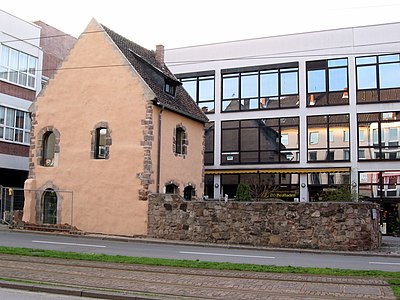Bower
A kemenate (also Kemnad; Latin caminus , -i , m. = Stove, fireplace, fireplace | caminata , -ae , heated living room) is a fireplace room .
Concept history
The early " castle- related " literature of the 19th century saw the Kemenate as a living and working room in a castle that could be heated by a fireplace or tiled stove ( Old High German cheminâta , Middle High German kemnâte , related to French cheminée , English chimney , Russian komnata ).
During the romanticism of castles in the 19th century, the term kemenate was associated with minnesong and ideal images of medieval castles. Although the bower was - often the only one - heated room (or wing) probably mostly reserved for the noble lords of the castle and their families (and probably also the sick), it was now interpreted in the sense of women's quarters, but this has no historical reference point. In historicist new buildings such as Neuschwanstein Castle , however, "kemenaten" were now often designed in large dimensions as part of the building ensemble.
Despite this new meaning of the term kemenate , the term is in the 14./15. Century documented sources and denotes a residential building there. Currently, however, none of the kemenate mentioned in the written sources from this time can be assigned to a building (or room in a real castle) that still exists today. Castle research today describes a massive stone structure, at least partially heated, as a bower. The heating was done with open chimneys or tiled stoves , often to save energy only in a single built-in plank room , which was sometimes above a kitchen, but very rarely with warm air heating , which only a few could afford. The multi-storey residential tower or - if the castle only had an uninhabitable defense tower, a donjon - a separate stone building, usually the hall, served as the bower of a medieval castle .
A caminata in the sources must be understood as a heatable room of the high and late Middle Ages , regardless of the reference to real rooms or social distinctions .
The Duden also defines Kemenate today as a colloquial , joking expression for an “intimate little room that someone has as their own personal area”.
Types
Designation for wide residential towers
The Thuringian-Saxon wide residential towers of various castles today usually bear the historically grown name Kemenate , such as the Kemenaten Orlamünde , Reinstädt , Ziegenrück or Schwallungen . When they were founded, these castles usually only consisted of these residential towers with one short and one long floor plan. They served as a tower castle or habitable watch tower . Later they were often expanded further, as in the case of Thurnau Castle in Upper Franconia . Wide residential towers also exist on Hessian castles. It is not known why the name Kemenate has become established for this type of castle. The designation alone does not allow any conclusions to be drawn about the use or type of heating.
It is certain that due to the considerable need for firewood in the castles and residential towers, only one room (or at most a few rooms) was heated, never the entire building. In the late Middle Ages - often in connection with the abandonment of large older castles - sometimes smaller residential towers without fortifications or tower houses were built in the style of wide residential towers. Examples of this are Kempe Castle in Breitenbach (Saxony-Anhalt) , after the Reichsburg Breitenbach was abandoned , or the “Gothic House” in Burgheßler , after the local “Hessler Castle” was razed, and the Saxon ruins of Burg Kempe and Burgstein .
Smaller heatable houses
A second type of bower is found in medieval cities. Here the houses of wealthy patrician merchants, which stood as half-timbered buildings on the street, occasionally had smaller rear buildings that were built from quarry stones on a square floor plan and that could be heated on the upper floor. They were built with a cellar and equipped with the eponymous fireplace. These massive stone rear houses were less fire-endangered than the representative front houses made of wood, clay and straw (mostly as half-timbered houses ). The small buildings at the back in the backyard served as a retreat for the family in the cold season and they often housed the smoke kitchen .
In Braunschweig there are archaeological records of such kemenaten from the late 11th to the 15th century. At the end of this period there were probably around 150, of which around 100 still existed until the destruction of World War II. Today there is still the Jakob-Kemenate (core around 1250) and the Kemenate Hagenbrücke (also 13th century), both of which have been renovated and used as cultural spaces. Occasionally such freestanding buildings, kept small for the purpose of heating and fire safety, are also found as parts of castle complexes, such as the Kemenate Schwallungen , a strikingly small residential tower from the beginning of the 13th century.
Even larger town houses with integrated black kitchens were sometimes given the name Kemenate in the Saxon-Thuringian region , such as the Kemenate Großbodungen or the Todenwarthsche Kemenate in Schmalkalden, but where the specific technical heating systems are often no longer verifiable today.
Jakob-Kemenate , Braunschweig
See also
literature
- Small dictionary of architecture. Philipp Reclam, Stuttgart 2008, ISBN 978-3-15-009360-3 , p. 71.
- Thomas Biller , G. Ulrich Großmann (ed.): Castle and palace. The aristocratic seat in the German-speaking area . Schnell & Steiner, Regensburg 2002, ISBN 3-7954-1325-7 , p. 84.
- Jens Friedhoff, Reinhard Friedrich: Kemenate. In: Horst Wolfgang Böhme , Reinhard Friedrich, Barbara Schock-Werner (Hrsg.): Dictionary of castles, palaces and fortresses. Philipp Reclam, Stuttgart 2004, ISBN 3-15-010547-1 , p. 168, doi: 10.11588 / arthistoricum.535 .
Web links
Individual evidence
- ↑ Kemenate, die , on duden.de
- ↑ What is a bower? In: Monumente 1 (2018), p. 34 f.




